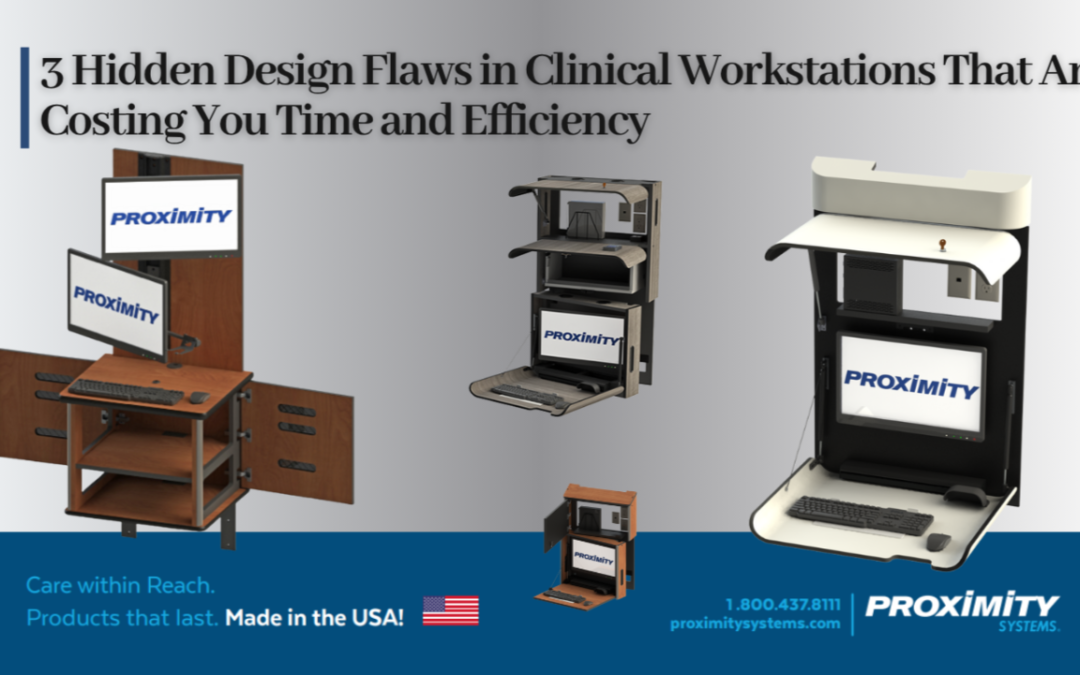In today’s healthcare environment, efficiency is a necessity. Clinical teams are under more pressure than ever to deliver high-quality care quickly and accurately. Amid these demands, hospitals and care centers have invested heavily in EMRs, diagnostics, and streamlined protocols. But there’s one tool that often gets overlooked—a tool that can make or break a smooth workflow:
👉 The workstation.
Whether it’s wall-mounted, mobile, or hybrid, the workstation serves as a critical link between clinicians, technology, and patients. But what if these everyday tools are doing more harm than good? Many facilities don’t realize that outdated or poorly designed workstations can introduce hidden inefficiencies that gradually chip away at care quality, staff satisfaction, and even safety.
At Proximity Systems, we don’t just build workstations—we reimagine them. Through thoughtful design, ergonomic engineering, and real-world feedback, we’ve identified several ways traditional setups can actually slow down clinical care—and how to fix them.
1. Poor Ergonomics = Fatigue, Frustration, and Errors
One of the most overlooked factors in clinical performance is physical comfort. Nurses and clinicians are on their feet for hours. They move fast, often in high-stress situations. If their workstation requires awkward angles, constant adjustments, or repetitive strain, fatigue sets in faster—and with fatigue comes mistakes.
Too many facilities use static-height workstations, poorly placed screens, or carts that are hard to maneuver. These setups force clinicians to adapt to the furniture, rather than the other way around. Over time, this leads to muscle strain, back and neck issues, and even time off work due to injury.
✅ What to Look For:
- Height-adjustable workstations (both wall-mounted and mobile)
- Monitor arms with fluid motion and easy adjustment
- Ergonomic layouts that support natural reach and posture
- Sit/stand options for flexibility during long shifts
At Proximity Systems, our designs prioritize movement and adjustability—so your equipment works with the human body, not against it.
2. Cable Chaos and Tech Tangles
In a perfect world, your clinical workstation is a clean, functional space. In reality? Tangled cables, loose power connections, overcrowded devices, and IT tickets for “the computer isn’t working again.”
Disorganized workstations aren’t just ugly—they’re inefficient and risky. When cords are exposed or tangled, cleaning becomes harder. Infection control protocols are compromised. Devices get damaged. And clinicians waste time troubleshooting or swapping out tech.
This is especially true as facilities add more digital tools: barcode scanners, tablets, EHR terminals, printers, and more. Without integrated cable management and power, workstations become cluttered catchalls instead of clean command centers.
✅ What to Look For:
- Enclosed cable management solutions that protect and simplify
- Integrated power and data access ports
- Charging docks and device holders built into the workstation
- Modular layouts that grow with your tech needs
Our units are built for the demands of modern tech-heavy care—streamlined, secure, and simple to clean and maintain.
3. Not Enough Room for Real Work
Clinical workstations are more than just a place to plug in a laptop. They’re hubs for note-taking, team huddles, quick patient lookups, and data entry. If the design is too compact, cluttered, or poorly placed, staff end up doing their work around the workstation rather than at it.
We’ve seen nurses charting on their laps in hallways, or balancing paperwork on top of a keyboard. That’s not just uncomfortable—it’s inefficient, unsustainable, and potentially unsafe.
Whether mobile or mounted, your workstations should support real-world clinical activity.
✅ What to Look For:
- Generous surface space for writing, scanning, and multi-tasking
- Integrated lighting for visibility during night shifts
- Easy-to-clean materials that meet infection control standards
- Placement that respects privacy, workflow, and patient experience
At Proximity, we ensure every design is backed by real clinical input. Because when space is optimized, productivity follows.
Bonus: The Psychological Cost of Bad Design
While these inefficiencies might seem minor on their own, the cumulative impact over hundreds of interactions per week can be staggering. Worse, they erode morale. If your team constantly battles their tools just to do their jobs, burnout isn’t far behind.
Great workstation design doesn’t just save time—it builds confidence. When clinicians feel supported by their environment, they move faster, think clearer, and provide better care. That’s not just good design. That’s smart healthcare.
The Proximity Systems Difference
At Proximity Systems, we understand the stakes. That’s why we don’t just sell workstations—we engineer smarter clinical environments. From wall-mounted units that blend seamlessly into patient rooms, to mobile carts that glide effortlessly through busy corridors, our solutions are built for:
✅ Durability
✅ Ergonomics
✅ Security
✅ Ease of use
✅ Aesthetic integration
Every detail is designed to eliminate friction and empower care teams to work at their best. Because when workstations work smarter, your staff does too.
📞 Let’s Build a Better Workflow Together
Ready to upgrade your clinical workstations or explore custom solutions for your space? Our team is here to help—from consultation through installation.
Contact Us Today:
📧 Email: sales@proximitysystems.com
📞 Phone: +1 (800) 437-8111
🌐 Website: www.proximitysystems.com
Let’s turn your workstations into a source of strength—not frustration. Because in healthcare spaces, practical can still be polished.
